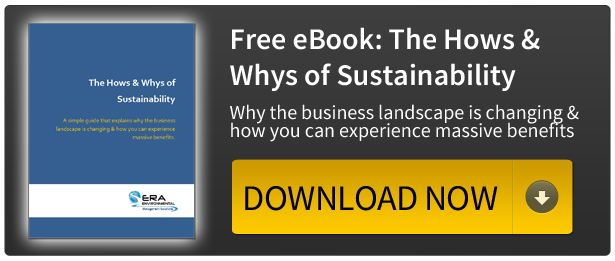 Some time ago, we wrote about the importance of not forgetting about the “easy wins” when it comes to your sustainability planning, especially for small businesses and for environmental teams that are struggling to find executive support for larger projects. In short, a less cost-intensive and simpler project like switching to energy efficient lighting or replacing one-use paper cups with reusable mugs can quickly reduce energy costs or waste production just enough to convince the higher-ups that sustainability and “thinking green” can actually improve your bottom line enough to get their buy-in for a longer-term or more expensive project.
Some time ago, we wrote about the importance of not forgetting about the “easy wins” when it comes to your sustainability planning, especially for small businesses and for environmental teams that are struggling to find executive support for larger projects. In short, a less cost-intensive and simpler project like switching to energy efficient lighting or replacing one-use paper cups with reusable mugs can quickly reduce energy costs or waste production just enough to convince the higher-ups that sustainability and “thinking green” can actually improve your bottom line enough to get their buy-in for a longer-term or more expensive project.
That’s why a recent article from Auden Schendler published on ThinkProgress really caught our attention. In it, he takes on the potential dangers that wait EH&S Managers that get lured in by the easy wins, or “low-hanging fruit” of sustainability. We thought it was an important read for anyone involved in sustainability projects and were curious to see if his warnings rang true in your own experience.
Use Caution When Choosing the Easy Wins
Here’s what Schendler has to say about easy wins:
“The problem is that even though “picking the low-hanging fruit” implies there’s more work to be done (now get the higher stuff!), nobody ever gets the ladder. Progress typically stops with the out-of-the-park home run project that was almost too good to be true, like a lighting retrofit. The result is that only the highest ROI projects comprise the entirety of an organization’s or household’s energy efficiency program, achieving, say, 5 or 10 percent of the total available carbon footprint reductions (if you’re lucky) and leaving the rest on the table.”
He argues that those quick bursts of great Return on Investment (ROI) ultimately skew our perception of what a sustainability project should generate, both in terms of money back and in time frame. Essentially, once those easy wins are done with, businesses are actually more likely to see larger-scale projects as inefficient or over-priced.
What Schendler suggests instead is to bundle the low hanging fruit and the more elaborate projects together:
“Here’s the essential problem: By doing the lucrative lighting retrofit on its own, you missed the opportunity to bundle it with other, lower return efficiency projects that are less attractive, and therefore, have prevented those projects from ever happening…
Bundling starts with a target and works backwards. … [M]anagers should first understand their energy universe and then establish goals. They can determine what mix of projects they need to get there at the very end of the process.”
Here he brings up a strong point, in that the most effective way to plan for sustainability is to know where it is you want go and to envision what corporate sustainability looks like for your business, and then map out how to get there in the most efficient route. For many businesses, this will require a mix of smaller projects and more complex endeavors.
Schendler also suggests that being able to accurately assess and measure the ROI of your projects is more important than you think when it comes to sustainability planning, and that one of the best ways to push through larger projects is to rethink your company’s business of ROI.
For example, although it is difficult to calculate the monetary ROI of some green projects, there are also inherent boosts to employee health, workplace morale, and your corporate public image. Schendler asserts that factors like these which are “obscure but just as real” should be included in your ROI calculations when determining which projects to carry through with. Sometimes factoring these types of non-physical ROI can be what you need to bring to the table when negotiating with key decision makers.
For an example, just look at Volkswagen’s large-scale Think Blue program, which has a large PR component in its execution. Even though Think Blue could work as a strictly internal operation, VW is upping the ROI of the project by incorporating a marketing/PR element.
Schendler also includes some other great examples of the unseen/oft-ignored ROI of projects:
- Older equipment costs more to maintain and tune up.
- More efficient equipment is usually smaller and less noisy. He suggests that reclaimed space could be very useful and even monetized in some cases.
- Less employee accidents/health risks associated with using a safer and less volatile fuel type.
He also notes the importance of taking a Systems Approach to measuring sustainability benefits. For example: “better insulation lets you reduce the size and capital cost of your heating system. More efficient lighting and better windows cut the quantity and cost of air conditioning required.”
Is Taking Easy Wins Bad Business?
Despite the warnings Schendler has about taking the easy wins, he admits that there is a time and a place for picking the low-hanging fruit:
“[C]ream-skimming projects can sometimes help grease the skids for future, bigger energy efficiency work by educating how incredibly profitable efficiency can be... After a few successes, managers might as well happily move forward with deeper (and typically lower return and longer tenor) investments.”
Using the easy wins in sustainability planning is to understand that real sustainability that aims at having a real impact on the environment and that promises you long-term results needs to go deeper. ERA calls it the Snowball Effect: getting a grip with smaller sustainability projects gets you the experience you’ll need to tackle larger projects, increases your chances of getting executive buy-in, and gives you more knowledge about how to properly assess ROI. Taking on one or two easy wins at first could be exactly what it takes to get that big project up and running, especially for businesses just starting off on the sustainability path.
So don’t discount the low-hanging fruit completely - just be aware that there’s a whole lot more to do once you’re done. And take Schendler’s advice: leave a few easy wins so that you can use them to bundle with and fuel those projects that need a little extra boost of ROI.
This blog was co-authored by:


Tags:
Sustainability
January 14, 2013


Comments